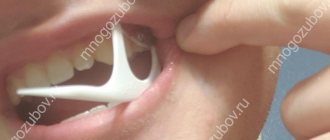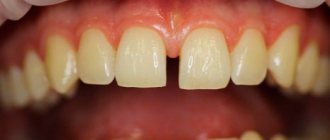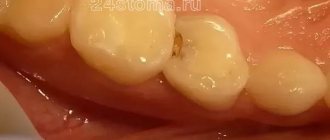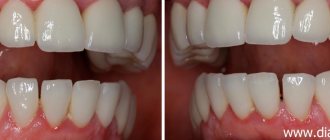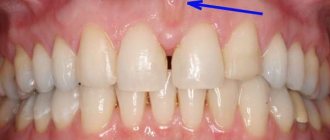A beautiful and snow-white smile is the adornment of every person. In order to achieve this, you need to visit the dentist regularly and pay great attention to hygiene. Not only dental diseases, but also gum diseases, the main symptom of which is pain, can negatively affect your appearance.
Gums hurt between teeth
Main reasons
There are many reasons that can cause gum discomfort. Some of them are harmless, and when the unfavorable factor is eliminated, the unpleasant symptom goes away on its own. If the pain is caused by diseases of the oral mucosa or teeth, treatment is required.
The following may cause temporary discomfort:
- Using a low-quality or hard brush.
- Traumatization of the gums by solid food.
- Taking certain medications.
If, after changing the brush to a softer one, your gums still continue to hurt, and trauma and medication are excluded, you can suspect one of the diseases of the oral cavity. In such cases, it is necessary to urgently visit the dentist.
Signs and consequences of tartar
Main causes of pain:
- Plaque. It contains a large number of pathogenic bacteria that cause inflammation and pain.
- Improper cleaning. “Plaques” are formed on the enamel, which are colonies of bacteria.
- External damaging factors. Various microtraumas can cause pathogenic microorganisms to penetrate into periodontal tissue, causing inflammation.
- Some diseases. Failure of the digestive and endocrine systems, as well as blood diseases, often cause pain in the gums.
If the pain spreads in the area of several teeth, then the cause most often lies in caries or an inflammatory process. In this case, it is important not only to relieve the unpleasant symptom, but also to cure the disease that caused it.
How to brush your teeth correctly
Why can a tooth hurt due to gum problems?
Picture of the process: an area of inflamed gum appears in the interdental spaces due to the fact that the contacts between the teeth are not very correct and food between the teeth slips onto the gum, injuring the gum. As a result, a pathological periodontal pocket is formed. Food gets stuck under the gum and penetrates close to the unprotected tooth root. The tooth begins to react to sweets and sours. And even if you clean the area under the gum from food debris, the pain may persist because the gum itself hurts. Patients often confuse that their gums or teeth hurt.
Dentists say in such cases that the contact points between the teeth are broken.
Gum diseases
There are 3 gum diseases that can cause pain. These include:
- Gingivitis.
- Periodontal disease.
- Periodontitis.
The main cause of gum inflammation is poor hygiene and the formation of stone and plaque, which activates the proliferation of pathogenic microflora. Inflamed gums begin to swell, turn blue or red. In advanced cases, tooth mobility appears, which can later cause tooth loss.
Gingivitis
Gums with gingivitis
Gingivitis is an inflammation of the gums, which most often causes pain between the teeth. It is superficial in nature, and at an early stage a person experiences the following symptoms:
- Redness and swelling.
- Bleeding.
- Itching.
- Unpleasant smell.
- The pain intensifies after eating.
As it progresses, small ulcers may form on the gums, which are particularly painful. Subsequently, the gum tissue decreases, which leads to exposure of the tooth root. There is severe discomfort while eating.
- Pocket in the gum between the teeth - how to treat
Important! The main cause of gingivitis is the formation of plaque due to poor hygiene.
Treatment is carried out by a dentist and depends on the severity of the gingivitis. Initially, plaque removal is required, and hygiene products are selected individually. In severe cases, overgrown gum tissue is removed.
Types of gingivitis
The standard treatment regimen includes the use of:
- Anti-inflammatory gels (Cholisal, Mundizal-gel, Kamistad).
- Paste (Lacalut fitoformula, Parodontax F, PresiDENT exclusive).
- Rinse aids (Lacalut “aktiv”, Paradontax, President profi).
- Vitamins (B1, C, A, E).
Treatment lasts 10 days. Treatment of gums with gels is carried out 2 times a day. Rinse aids are used after meals. During treatment, it is necessary to use a soft brush to avoid further trauma to the gums.
Periodontitis
Inflammatory gum disease, which is characterized by damage to periodontal tissue. It is a consequence of untreated gingivitis.
Gums with periodontitis
The symptoms are similar to gingivitis, but other unpleasant signs appear:
- Severe swelling and suppuration.
- Pain when touched.
- Gaps between teeth and their loosening.
Periodontitis can be caused by failure to comply with hygiene rules, deficiency of vitamins and beneficial microelements, and improper bite and tooth shape. The treatment regimen coincides with therapy during gingivitis. After removing plaque and stone, a person needs to carefully maintain hygiene for 2 weeks.
Stages of periodontitis
Important! Advanced stages of periodontitis require cutting the tissues surrounding the tooth and removing deep stone.
Local treatment includes the use of anti-inflammatory gels (Acepta, Cholisal, Mundizal-gel). If tooth mobility occurs, the installation of temporary splints is required, which can be replaced with a prosthesis if necessary.
Periodontal disease
Damage to periodontal tissue. Pain occurs not only between the teeth, but also around them. The disease occurs rarely - no more than 8% of dental patients. Leads to increased tooth mobility and does not relate to inflammatory pathologies. Symptoms:
- Bleeding.
- Exposing the neck of the teeth.
- Severe pain.
- Tissue atrophy.
Periodontal diseases
The main reason is poor circulation in the periodontal tissues. Periodontal disease is often a consequence of systemic diseases of the body (diabetes, atherosclerosis, hypertension). It can occur in people with a hereditary predisposition.
- Caries between teeth - why I have it and my neighbor doesn’t
The treatment is long-term, and at the first stage includes the removal of tartar. Severe stages require the use of gels, ointments and rinses with an anti-inflammatory effect. If there are carious teeth, they are treated.
Local treatment includes:
- Rinse with 0.05% Chlorhexidine solution.
- Applications "Cholisal gel".
Dental gel Cholisal
The average duration of treatment is 10 days. Rinsing with Chlorhexidine solution should be done in the morning (after breakfast) and in the evening. Then the teeth and gums are dried with a cotton swab and the gel is carefully applied to the marginal part of the gum. After using medications, it is not recommended to eat for 2 hours.
Symptoms of periodontitis
Periodontitis is called the “silent killer of teeth”, since in the initial stages this disease is asymptomatic, without the presence of acute painful sensations. Accordingly, patients often do not pay attention to bleeding gums that occur from time to time. But it is in the initial period that the disease is treatable. Pronounced symptoms most often occur when the teeth can no longer be saved. Developed periodontitis cannot be completely cured, you can only slow down the process of its further development.
Mild degree. As a rule, the disease begins with inflammation of the gums - gingivitis. Characteristic symptoms are swelling and redness of the gums, their bleeding due to mechanical irritation, for example, while brushing your teeth or eating solid foods. At this stage, tissue damage is reversible, since the process has not yet affected the interdental ligaments and jaw bone.
Average degree. If action is not taken in time, the infection spreads deep into the gums and destroys the ligaments that hold the teeth. The gums begin to peel off, and between it and the wall of the teeth, so-called “pockets” deepen - crevices in which bacteria accumulate. Their depth, which is normally 3 mm, increases to 6 mm. The spaces between the teeth widen, bad breath appears, the gums become loose and bleed constantly.
Severe degree. Further progress of the disease leads to receding gums and exposure of the necks of the teeth. The depth of the gum pockets can reach from 7 to 10 mm. The teeth become extremely sensitive, and in addition to blood, purulent discharge appears. The jawbone in which the teeth are attached begins to deteriorate. They lose stability, become loose and fall out. In some cases, with severe periodontitis, the temperature may rise and general health may deteriorate.
Pain after treatment
Often discomfort between teeth occurs after treatment. This may indicate poor-quality filling and the development of infection inside the canal. In this case, you need to take an x-ray, with which you can immediately detect the pathology.
Important! Trauma to the gums can occur due to an “overhanging” filling that comes into contact with the gingival papilla.
You can detect a filling defect by using dental floss that gets stuck or breaks. Treatment requires correction of the filling or its replacement. Microtrauma from a filling or crown can cause discomfort in the first days after dental treatment. The pain goes away on its own after a few days.
Video - Gums hurt: what to do?
Why does food get stuck between treated teeth?
dentistry teethprostheticsemax high-quality dental prostheticscrownstropedic dentistryveneersceramic inlaysprosthetic crownsHollywood smile white teethpearl teethbeautiful smileimplantationwedge-shaped defectsgingival recessiontreatment of children high-quality dentistry baby teeth colored fillings dental implantation Ankylos implantation high-quality implantation without bone tissue augmentation qualified implantation front teeth prosthetics veneers ceramic crowns Imax e.Max zirconium crowns dental prosthetics with crowns depressurization of composite restoration marginal staining re-polishing of fillings professional examination veneer tooth lightening ceramic veneers exclusive prostheticsgold inlayfront tooth single crownDamon bracesimplantTeeth crowdingOrthognathic surgery Victory bracesMEAW technique multi-loop arch IVD Sato meaw orthodonticSplint therapy wedge-shaped defect treatment of a wedge-shaped defect tooth restorationRestoration of teeth re-polishing fillings artistic restorationExtraction of the inlay remove the inlay from the rootAnchor pin preparation for prostheticsadditional canal cyst treatmentProfessional hygiene clean dental treatmentResection of the root apex Apicotomy Retrograde treatmentSingle-stage implantation Tooth implantation ImplantArtistic restoration treatment of caries Teeth cleaning One-stage implantation Ankyloses Implantation of a tooth with a crack cracked root implantation of a front tooth Ranula retention cyst wound removal save tooth tooth preservation alternative to implantation CCPD SST Ankylos Ankylos FDM implant implant wisdom tooth treatment mock-up mock-up prototyping elastics intermaxillary traction braces hygiene products implantation Astra Astra Tech Panov Mikhail Yurievich dental transplantation dental treatment treatment under a microscope treatment under a microscopeCanal treatmentHollywood smiletooth transplantationTooth extrusionTreatment without preparationTreatment without preparationTreatment tool in the tooth canal Panov Mikhail Yurievich tooth saving treatment of canals filling gum recessionSealing fissure resection of the root apexTeeth preservationIntrusionGum recessiontransplantationDental cariesSST
Treatment
Treatment for pain in the gums depends on the causes of the discomfort. If the pain is caused by pieces of food stuck in the interdental space, careful oral hygiene and flossing are sufficient. If fillings are installed poorly, they are replaced. Gum inflammation requires the use of anti-inflammatory ointments, gels and rinses.
Important! Painkillers should only be taken as prescribed by a specialist, as they negatively affect the gastrointestinal tract and are not able to eliminate the main cause of discomfort.
Treatment should be carried out by a doctor, but if there is no possibility of contacting a specialist, you can use one of the proposed anti-inflammatory drugs:
| Name | Image | Description | Price |
| Ointment "Parodontocide" | It has analgesic, regenerating and anti-inflammatory properties. Apply after brushing your teeth with a cotton swab or finger. | 125 RUR | |
| Rinse aid "Asepta" | Use after meals. Contains chlorhexidine and benzydamine, which relieve pain and swelling | 170 RUR | |
| Gel "Metrogil Denta" | A drug based on chlorhexidine and metronidazole. Helps relieve pain, inflammation and swelling, reduces bleeding gums. Use 3 times a day | 270 RUR | |
| Gel "Troxevasin" | Gel for relieving inflammation, which strengthens the walls of blood vessels and makes them more elastic. Apply to the damaged area morning and evening | 230 RUR |
- How to close a gap between your front teeth

